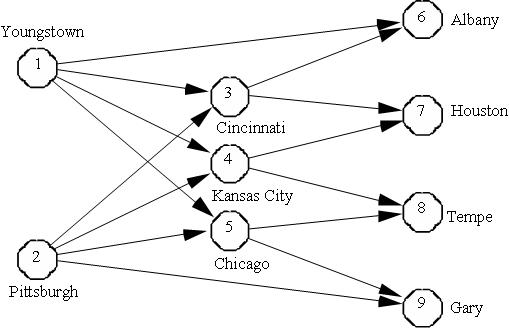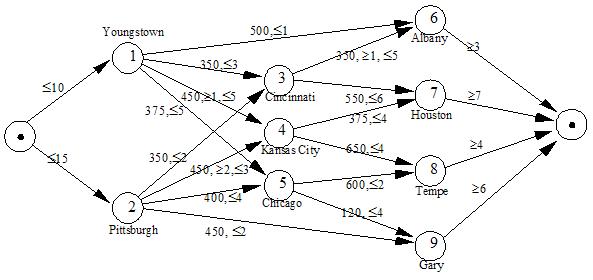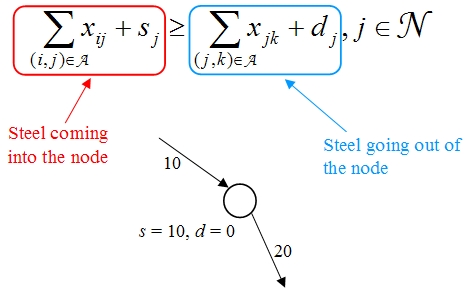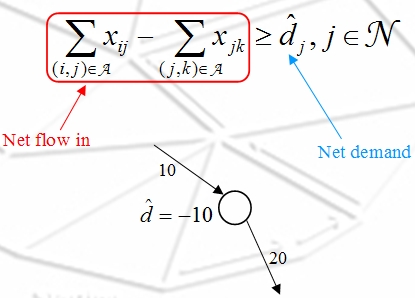The Transshipment Problem
The transshipment problem is very similar to the transportation problem. It has supply nodes In Figure 1
In Figure 1 Formulating the Transshipment Problem
Transshipment problem are network optimisation problems. Network optimisation problems are solved using mathematical programming. Thus, to formulate a transshipment problem we use the 4 steps for formulating a mathematical programme:- Identify the Decision Variables
- Formulate the Objective Function
- Formulate the Constraints
- Identify the Data
Identify the Decision Variables
The decision variables in the transshipment problem are the flowFormulate the Objective Function
The objective of the transshipment problem is to minimise the total cost of delivering goods through the network. The cost of shipping a flow ofFormulate the Constraints
The constraints for the transshipment problem are straightforward:- Flow out of a supply node is less than the supply available;
- Flow must be conserved at transshipment nodes;
- Flow into a demand node is more than the demand requested.
Identify the Data
The transshipment problem formulation is:![\[ \begin{array}{r@{\,}r@{\,}l} \min & \displaystyle \sum_{(i, j) \in {\cal A}} c_{ij} & x_{ij} \\ \text{subject to} & \displaystyle \sum_{(i, j) \in {\cal A}} & x_{ij} \leq s_i, i \in {\cal S} \\ & \displaystyle \sum_{(i, j) \in {\cal A}} & x_{ij} = \displaystyle \sum_{(j, k) \in {\cal A}} x_{jk} , j \in {\cal T} \\ & \displaystyle \sum_{(i, j) \in {\cal A}} & x_{ij} \geq d_j, j \in {\cal D} \\ & l_{ij} \leq & x_{ij} \leq u_{ij}, (i, j) \in {\cal A} \end{array} \]](/pub/OpsRes/TransshipmentProblem/latexcc2b58978eaea97842cedc89c9b0a2e0.png)
- the set of nodes
 , split into 3 subsets
, split into 3 subsets  ;
;
- the set of arcs
 ;
;
- the supply and demand values,
 ;
;
- the shipping costs
 ;
;
- the bounds on flow
 .
.
Network Formulation
Transshipment problem formulations can also be expressed in network form. The nodes and arcs are drawn explicitly with the shipping cost and flow bounds shown for each arc. To represent the supply (respectively demand) a source (sink) node is added with new arcs from the source node to the supply nodes (from the demand nodes to the sink node). The bounds on these arcs represent the supply (demand) at the supply (demand) nodes.explicitly. Figure 2 shows the network formulation for the the American Steel Transshipment Problem. Figure 2 The network formulation for the American Steel Transshipment Problem
Alternative Formulation
Rather than split the nodes into three disjoint sets with associated constraints, we can redefine the supply and demand constants to allow for one flow conservation constraint for all the nodes. We will show how to do this in a couple of steps. First, we consider all the flow into a node, i.e., the flow from other nodes + the supply at the node. This must be more than the flow out of a node, i.e., the flow to other nodes + the demand at the node, as we cannot create flow out of thin air. Figure 3 shows the new constraint and an example of how flow into a node, 10 (flowing in) + 10 (supply), equals flow out of a node, 20 (flowing out). Figure 3 An alternative flow conservation constraint The
The  Now
Now ![\[ \hat{d}_j = \begin{cases} -s_j & j \in {\cal S} \\ d_j & j \in {\cal D} \\ 0 & j \in {\cal T} \end{cases}, j \in {\cal N} \]](/pub/OpsRes/TransshipmentProblem/latexcd29afe5137311847f5b76b7addbcc82.png)
![\[ \begin{array}{r@{\,}r@{\,}l} \min & \displaystyle \sum_{(i, j) \in {\cal A}} c_{ij} & x_{ij} \\ \text{subject to} & \displaystyle \sum_{(i, j) \in {\cal A}} & x_{ij} - \displaystyle \sum_{(j, k) \in {\cal A}} x_{jk} \geq \hat{d}_j, j \in {\cal N} \\ & l_{ij} \leq & x_{ij} \leq u_{ij}, (i, j) \in {\cal A} \end{array} \]](/pub/OpsRes/TransshipmentProblem/latex41f66a78926e3ce64b7c602f4f43a554.png)
Naturally Integer Solutions
The transshipment problem is often an integer programme as the quantity of goods delivered along the arcs must be integer. However, if the supply, demand and variable bounds are integer, then (like the transportation problem) the transshipment problem will have naturally integer solutions. This means that any solution found using linear programming will have integer values.Solving the Transshipment Problem with OR Software
To see examples of transshipment problems, check out some of the transshipment problem case studies:Results from OpsRes web retrieved at 03:00 (GMT)
\usepackage{amsmath} Case Study: Submitted: Operations Research Topics: Application Areas: Contents Problem Description Problem Description Return...
\usepackage{amsmath} Case Study: Submitted: Operations Research Topics: Application Areas: Contents Problem Description Problem Description Return...
Number of topics: 2
-- MichaelOSullivan - 08 Apr 2008 Topic revision: r21 - 2019-11-11 - MichaelOSullivan
Ideas, requests, problems regarding TWiki? Send feedback

